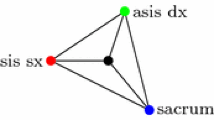Abstract
This paper presents a human walking model built from experimental data based on a wide range of normalized velocities. The model is structured on two levels. On the first level, global spatial and temporal characteristics (normalized length and step duration) are generated. On the second level, a set of parameterized trajectories produce both the position of the body in space and the internal body configuration. This is performed for a standard structure and an average configuration of the human body.
The experimental context corresponding to the model is extended by allowing a continuous variation of global spatial and temporal parameters according to the motion rendition expected by the animator. The model is based on a simple kinematic approach designed to keep the intrinsic dynamic characteristics of the experimental model. Such an approach also allows a personification of the walking action in an interactive real-time context in most cases. A correction automata of such motion is then proposed.
Similar content being viewed by others
References
Armstrong WW, Green MW (1985) Dynamics for animation of characters with deformable surfaces. In: Magnenat-Thalmann N, Thalmann D (eds) Computer-generated images. Springer, Tokyo Berlin Heidelberg New York, pp 209–229
Arnaldi B, Dumont G, Hégron G, Magnenat-Thalmann N, Thalmann D (1989) Animation control using dynamics. In: Magnenat Thalmann N, Thalmann D (eds) State of the art in computer animation. Springer, Tokyo Berlin Heidelberg New York, pp 113–123
Badler NI, Smoliar SW (1979) Digital representation of human movement. ACM Comput Surv 11 (1):19–38
Bruderlin A, Calvert TW (1989) Goal directed, dynamic animation of human walking. Proc SIGGRAPH '89, Computer Graphics 23(3):233–242
Calvert TW, Chapman J (1978) Notation of movement with computer assistance. Proc ACM Annual Conf 2:731–736
Dreyfuss H (1966) The measure of man, 2nd edn. Withney Library of Design, New York
Eshkol N, Wachmann A (1958) Movement notation. Weidenfeld and Nicolson, London
Espiau B, Boulic R (1985) Collision avoidance for redundant robots with proximity sensors. Proc 3rd International Symposium of Robotic Research. Gouvieux, France, October
Ferrigno G, Pedotti A (1985) ELITE: a digital dedicated hardware system for movement analysis via realtime TV signal processing. IEEE Trans Biomed Eng BME 32(11):943–950
Girard M (1987) Interactive design of 3 D computer-animated legged animal motion. IEEE Comput Graph Appl 7(6):39–51
Girard M (1989) Constrained optimization of articulated animal movements in computer animation. MIT Workshop on Mechanics, Control, and Animation of Articulated Figures
Girard M, Maciejewski AA (1985) Computational modeling for computer generation of legged figures. Proc SIGGRAPH '85, Computer Graphics 19(3):263–270
Gurfinkel VS, Fomin SV (1974) Biomechanical principles of constructing artificial walking systems. In: Theory and Practice of Robots and Manipulators, vol. 1. Springer, Berlin Heidelberg New York, pp 131–141
Hemami H, Farnsworth RL (1977) Postural and gait stability of a planar five-link biped by simulation. IEEE Trans Automatic Control AC 22(3):452–458
Hutchinson A (1970) Labanotation. Theatre Books, New York
Inman VT, Ralston HJ, Todd F (1981) Human walking, Williams and Wilkins, Baltimore
Isaacs PM, Cohen MF (1987) Controlling dynamic simulation with kinematic constraints, behavior functions and inverse dynamics, Proc SIGGRAPH '87, Computer Graphics 21(4):215–224
Koparkar PA, Mudur SP (1983) A new class of algorithms for the processing of parametric curves. Computer-aided design 15(1):41–45
Kreighbaum E, Barthels KMB (1985) Biomechanics, a qualitative approach, 2nd edn. Burgess, Minneapolis
Lamoreux LW (1971) Kinematic measurements in the study of human walking. Bulletin of Prosthetics Research BPR 10(15)
Magnenat-Thalmann N, Thalmann D (1987) The direction of synthetic actors in the film Rendez-vous à Montréal. IEEE Computer Graphics and Applications 7(12):9–19
McMahon T (1984) Mechanics of locomotion. Int J Robotics Res 3(2):4–28
Miura H, Shimoyama I (1984) Dynamic walk of a biped. Int J Robotics Res 3(2):60–74
Murray MP, Drought AB, Kory RC (1964) Walking patterns of normal men. J Bone Joint Surg (Am) 46(2):335–360
Murray P, Kory RC, Clarkson BH, Sepic SB (1966) Comparison of free and fast speed walking patterns of normal men. Am J Phys Med 45(1):8–24
Murray P (1967) Gait as a total pattern of movement. Am J Phys Med 46(1):290–333
Saunders JB, Inman VT, Eberhart HD (1953) The major determinants in normal and pathological gait. J Bone Joint Surg (Am) 35:543–558
Thalmann D, Magnenat-Thalmann N, Wyvill B, Zeltzer D (1988) SIGGRAPH '88 Tutorial notes on synthetic actors: the impact of AI and robotics on animation
Wilhelms J (1987) Using dynamic analysis for realistic animation of articulated bodies. IEEE Computer Graphics Appl 7(6):12–27
Zarrugh MY, Radclifh CW (1979) Computer Generation of Human Gait Kinematics. J Biomech 12:99–111
Zeltzer D, Sims K (1988) A figure editor and gait controller to task level animation. In: Thalmann D, Magnenat-Thalmann N, Wyvill B, Zeltzer D, SIGGRAPH '88 Tutorial Notes on Synthetic Actors: the Impact of A.I. and Robotics on Animation, pp 164–182
Author information
Authors and Affiliations
Rights and permissions
About this article
Cite this article
Boulic, R., Thalmann, N.M. & Thalmann, D. A global human walking model with real-time kinematic personification. The Visual Computer 6, 344–358 (1990). https://doi.org/10.1007/BF01901021
Issue Date:
DOI: https://doi.org/10.1007/BF01901021




